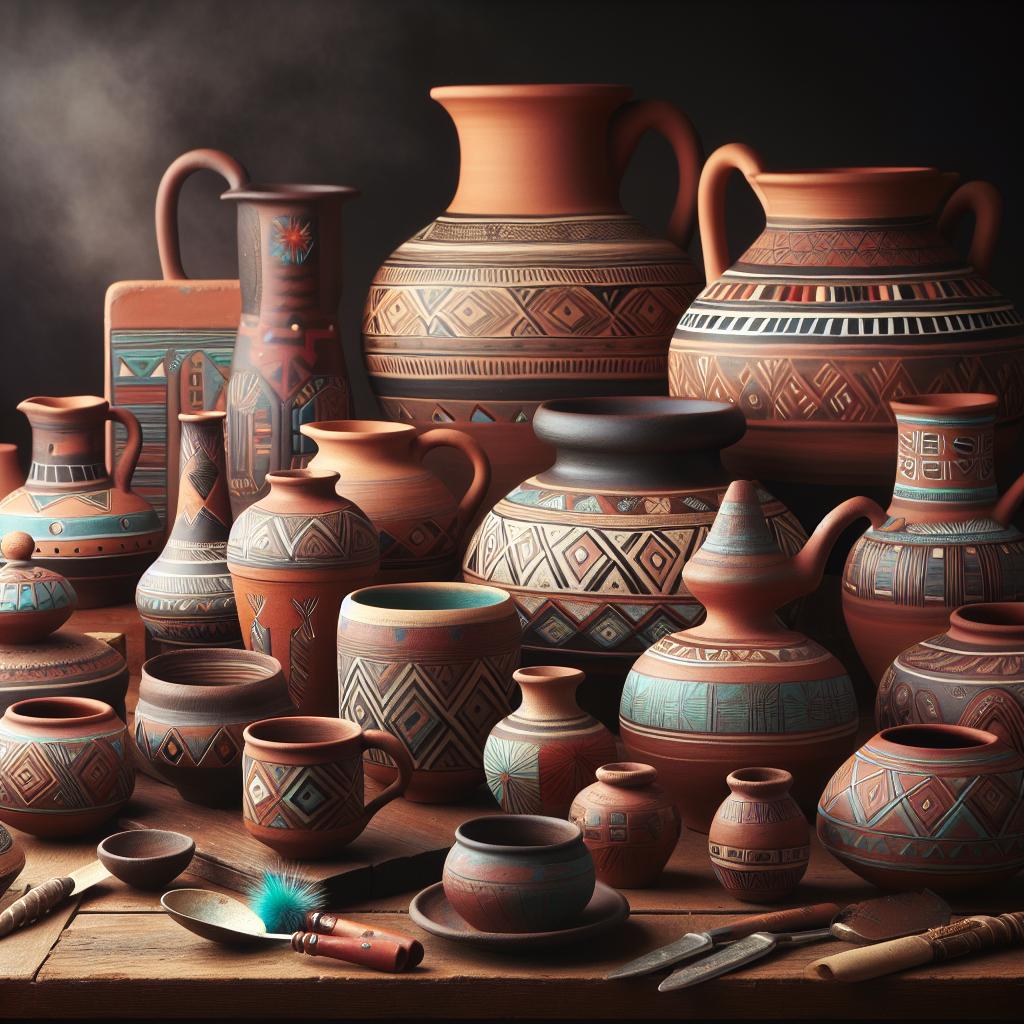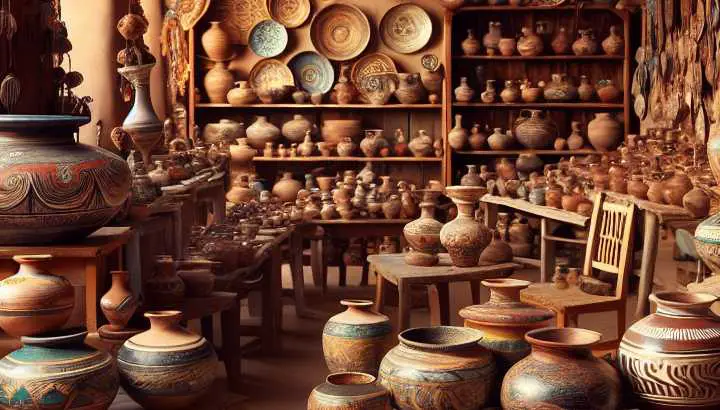Profiles of Renowned Southwest Pottery Artists

Influential Southwest pottery artists and their works
Pottery chucking enthusiasts, charming clay connoisseurs, rejoice! Today, we’re embarking on a journey—a colorful, ceramic-laden odyssey through the Southwest—rustic territory teeming with great pottery artists. These mud-wielding maestros have left undeniable imprints on the sun-bleached canvas of the Southwest, their influential works perched atop creaky wooden shelves and nestled in dusty museums with appropriately Western-sounding names like ‘Prickly Pear Museum of Art’.
First on our aesthetically pleasing agenda, brace yourselves for the queen bee of pottery, Maria Martinez. This remarkable woman and her magical hands have whipped up incredible pottery works that could make Michelangelo blush more vividly than a Santa Fe sunset.
Known for her black-on-black pottery technique—a visually striking style akin to trying to spot a tarantula scurrying across a moonless desert night—Martinez’s work exhibits a beautiful dance of contrasts. In fact, when you ask Siri to ‘show examples of Southwest pottery’, she’ll simply point you to the Martinez wing at the Smithsonian.
Next, let us trip the light fantastic with the legendary Nampeyo of Hano. Known simply as Nampeyo—an artist doesn’t truly reach the pinnacle until their first name suffices, right, Beyonce?—this Tewa-Hopi potter practically put Hopi pottery on the map, and we’re talking the Google Maps kind of map, not your flimsy, chile-stained road atlas.
Nampeyo’s technique evoked images of ancient Hopi pottery, breathing new life into old ceramics like a seasoned potter performing CPR on her favorite kiln. She was renowned for her Sikyatki Revival pottery, a mesmerizing mélange of geometric patterns and earthy yellows that can draw you in like a tumbleweed bewitched by a desert whirlwind.
And finally, folks, we can’t talk about Southwest pottery shapers without mentioning Tony Da—neither a British DJ nor an Italian mobster, but a heralded San Ildefonso Pueblo artist.
“But the real cause of offence against these two great and good men was that they were the two most influential Protestants in Scotland, and must therefore be removed out of the way”
~ Unknown, Unknown
Tony Da, grandson of the aforementioned Maria Martinez (oh, the power of genetics!), applied his inventive touch to the pottery world, cross-pollinating traditional pottery with contemporary concepts.
From inlaying turquoise and silver into pottery—an audacious move equivalent to adding Ghost peppers to grandma’s chili recipe—to his iconic mutated turtles and abstract sgraffito, his work showcases a fearless blend of humor, rebellion, and innovation, sizzling the serene landscape of traditional pottery like a stubborn sagebrush under the sweltering desert sun.
So, there you have it, a whistle-stop tour around a few of the most influential Southwest pottery artists ever to spin a wheel. It’s quite like a thrilling wild-west roller coaster ride, only instead of gunfights and bar room dust-ups, we have pots, lots of pots—beautiful, spectacular pots.
Don’t forget to tip your hat to these Southwest stalwarts. They serve as reminders that creativity can spring forth from the most unassuming clay, like a stubborn desert flower expressing its radiant bloom against unforgiving, arid land.
Like This? Try: Influential Southwest Pottery Artists And Their Works

Cultural influences in Southwest pottery artistry
Title: The Clay Alchemy – Cultural Influences in Southwest Pottery Artistry
Southwest pottery artistry is a compelling and intricate red-dirt saga, spoken through whispers of pottery colors and the tattoo of pictorial designs. It’s like Oprah Winfrey hosting a prime time talk show with Pablo Picasso, Georgia O’Keeffe, and the ancient Pueblo people, all at once. Stay tuned; it’s much more than a highbrow pottery skills exchange. It’s a captivating chronicle that weaves time, culture, and place into a must-see spectacle.
Imagine the red, earthy, open landscapes of the Southwest. Tumbleweeds are somersaulting their way across the horizon while Clint Eastwood sternly surveys the land, squinting through the dust. If Clint were an archaeologist rather than a gunslinger, it’s the Southwest’s rich repertoire of pottery he’d be keen on.
This artistry, with ancient roots trailing back over 2000 years, was developed by indigenous tribes such as the Navajo, Hopi, and Zuni. They discovered that the clay beneath their feet held a remarkable secret; it could sing the long-lost tales of their ancestors. And they’ve been playing this note-rich symphony of clay wizardry ever since.
The pottery artistry from this region tells a tale of cultural influence as colorful as a rainbow hitching a ride in an abstract art exhibit. Celebrated for its bold geometric designs and earthen tones, the pottery is as much a part of the region as cowboy boots and spicy chili peppers. But wait, we’re not talking Mona Lisa-esque demure smiles delicately dripping from the pottery.
“Now was demanded compression, nervous rapidity of movement, sharpness of characterization, singleness of impression, culmination, _finesse_–a studied artistry that may be compared with even the best work of the French school of the same period”
~ Unknown, Unknown
It’s more of a spirited, heart-thumping tribal dance imbued into earthenware.
Firstly, let’s get into the zone with the famous ‘Pueblo Pottery.’ Imagine pots holding hands around a merry bonfire, singing tales of corn agriculture and spiritual kachina dolls, replete with their life tales etched in clay. That’s Pueblo pottery for you – a blend of utility and beauty that gives Martha Stewart’s home décor a run for its money.
On the other hand, Hopi pottery brilliantly captures the trifecta of art, function, and storytelling in its swirling geometric designs. If you squint hard enough, you would swear those intricate motifs are ancient Hopi ‘emojis’ narrating epic tales of their adventures, ceremonies, or maybe their last potluck dinner. Who needs Facebook for timeline updates when you have Hopi pottery?
Navajo pottery, meanwhile, is the pottery equivalent of Elvis Presley. It shook up the traditional rules with its signature “Navajo White” style, drenched in natural pigments of white clay slipped over red. It’s a ceramics fashion statement that screams ‘less is more’ in bold, capital letters.
Southwest pottery is a stage where cultural traces pirouette beautifully with creativity, pouring life into lumps of clay, defying the sands of time. So next time you see a piece of this pottery, remember, it’s not just some pretty art. It’s a cultural emissary from the sun-drenched southwest landscapes, relaying an age-old tale of innovative artistry.
Beauty, utility, storytelling – Southwest pottery has definitely got its clay game on point. Even Paul Revere and his silversmithing skills would have to tip his hat to that! After all, it’s not every day you see a humble dab of clay dance delightful pirouettes of ancient tales in your living room. Now, that’s something to chai-toast to!
Read More: Cultural Influences In Southwest Pottery Artistry

Techniques and styles of renowned Southwest pottery artists
If you’ve ever observed a finely crafted pot on a sunny afternoon and pondered, “I wonder how a handful of dirt can develop such an exquisite personality?”, then this article is for you. Grab yourself a cup of hot cocoa (or in southwestern style – a mug of spicy hot chocolate with a cactus motif), and settle in as we dive into the craftily molded world of southwest pottery artists.
The southwest of the U.S., with one foot on the throttle of modern civilization and the other rooted in active preservation of indigenous culture, has nursed some exceptional pottery artists into the limelight. To start your clay-soaked adventure, let’s start with Maria Martinez, the Meryl Streep of pottery, widely acclaimed for being a little bossy with mud and fire.
Martinez’s technique, hailing from the Pueblo Native American culture, pays homage to the philosophy of yin and yang. Black-on-black pottery is her signature style, creating glossy and matte designs that play a friendly game of hide-and-seek on the surface. It’s almost as though these vessels come with a dimmer switch, depending on where sunlight chooses to gently caress them.
Another noted savant of southwest pottery, Tony Da, a San Ildefonso Pueblo potter, broke the mold by introducing sgraffito into the mix. Sgraffito, undoubtedly a word that’s as fun to say as the techniques it involves – is a method where artists scratch designs into a layer of slip (liquid clay) before firing. Da’s unique style presents beautifully etched pots, reminiscent of scratch-off lottery tickets, minus the anxiety and potential disappointment.
Making a majestic entrance next are the Hopi potters, who have gracefully mastered the coil-and-scrape technique, crafting epic tales of their heritage on the pot’s canvas. Guided by pottery goddess Nampeyo, they weave intricate symbols, images, and scenes onto their pottery. Their palette is all of three colors – red, yellow, and white clay – giving a new meaning to the term ‘three-color scheme’. Picasso may have had his blue period, but the Hopi potters are rocking their three-color millennium.
Have you ever seen pottery go through a midlife crisis? That’s what the Mata Ortiz pottery style looks like, and it’s all thanks to Juan Quezada.
“”The bird also began to play in semi-human style, performing marvellous acrobatic feats on the clothes-line, and lying on its back juggling with a twig as some artists do with a barrel in the circus.””
~ E J Banfield #2 in our series by E J Banfield , My Tropic Isle
He re-discovered this long-lost style associated with the ancient Paquimé culture, turning pottery from smooth and round to angular and edgy. Quezada’s work seems to taunt physics itself, creating vessels that are impossibly thin and impossibly gorgeous – echoing the remarkable balance of strength and fragility inherent in nature.
Last but absolutely not ‘least’, are the Acoma Pueblo potters, the vertically-challenged show-offs of the pottery world. Their slender, delicate pieces with fine-line geometric designs are a remarkable feat in clay-morphing. It’s like watching a runway fashion show, but instead of models, you have expertly crafted pottery strutting their stuff in their multicolored ensembles.
Southwest pottery holds a world within itself, a world where dirt and water dance under knowing hands, embraced by fire, and cooled under the soft gazes of artists. These renowned pottery artists, with their nuanced techniques leaning against the cradle of their heritage, are the guardians of a tradition that showcases simplicity in complexity, and vice versa. Each pot, vessel, or urn holds a dialogue between the past and the present, the artist and the observer, embodying the spirit of southwest in every curve, texture, and hue.
So, the next time you hold a southwest pottery piece in your hand, remember that you’re not just holding a fancy pot. You’re holding centuries of stories, of smiles and tears, of civilization and wilderness. You’re holding a piece of the soul of the craftsperson, suspended in time, whispered into your ears via a secret language of clay and fire. And that, my friend, is the magic of southwest pottery!
Learn More: Techniques And Styles Of Renowned Southwest Pottery Artists
